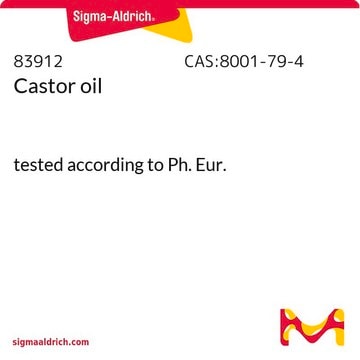12392
Benzyl benzoate
tested according to Ph. Eur.
Synonim(y):
Benzylis benzoas, Benzoic acid benzyl ester
About This Item
Polecane produkty
agency
USP/NF
tested according to Ph. Eur.
Poziom jakości
ciśnienie pary
1 mmHg ( 125 °C)
Postać
liquid
temp. samozapłonu
896 °F
kolor
clear
współczynnik refrakcji
n20/D 1.568 (lit.)
tw
323-324 °C (lit.)
mp
17-20 °C (lit.)
rozpuszczalność
alcohol: miscible
chloroform: miscible
diethyl ether: miscible
oil: miscible
water: insoluble
gęstość
1.118 g/mL at 20 °C (lit.)
Zastosowanie
pharmaceutical (small molecule)
ciąg SMILES
O=C(OCc1ccccc1)c2ccccc2
InChI
1S/C14H12O2/c15-14(13-9-5-2-6-10-13)16-11-12-7-3-1-4-8-12/h1-10H,11H2
Klucz InChI
SESFRYSPDFLNCH-UHFFFAOYSA-N
Szukasz podobnych produktów? Odwiedź Przewodnik dotyczący porównywania produktów
Zastosowanie
Działania biochem./fizjol.
Hasło ostrzegawcze
Warning
Zwroty wskazujące rodzaj zagrożenia
Zwroty wskazujące środki ostrożności
Klasyfikacja zagrożeń
Acute Tox. 4 Oral - Aquatic Acute 1 - Aquatic Chronic 2
Kod klasy składowania
10 - Combustible liquids
Klasa zagrożenia wodnego (WGK)
WGK 2
Temperatura zapłonu (°F)
298.4 °F - closed cup
Temperatura zapłonu (°C)
148 °C - closed cup
Środki ochrony indywidualnej
Eyeshields, Faceshields, Gloves, type ABEK (EN14387) respirator filter
Choose from one of the most recent versions:
Masz już ten produkt?
Dokumenty związane z niedawno zakupionymi produktami zostały zamieszczone w Bibliotece dokumentów.
Klienci oglądali również te produkty
Nasz zespół naukowców ma doświadczenie we wszystkich obszarach badań, w tym w naukach przyrodniczych, materiałoznawstwie, syntezie chemicznej, chromatografii, analityce i wielu innych dziedzinach.
Skontaktuj się z zespołem ds. pomocy technicznej









